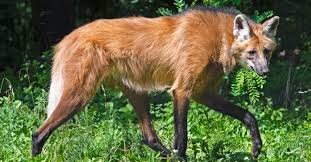Types of Wild Dogs and their Characteristics
There are several different types of wild dogs found around the world. Wild dog is a term that can refer to a number of different species of wild canids, depending on the region and context including:
1. African Wild Dog: also known as the painted dog, the African wild dog is a critically endangered species found in sub-Saharan Africa. They are known for their striking coat patterns, which feature a mix of black, brown, and white patches.
2. Dingo: this wild dog is native to Australia and is considered a subspecies of the domestic dog. Dingoes have been living in the wild in Australia for thousands of years.
3. Coyote: found in North and Central America, coyotes are adaptable and can be found in a variety of habitats, including deserts, grasslands, and forests.
4. Gray Wolf: the gray wolf is found in North America, Europe, and Asia, and is known for living and hunting in packs. They have a distinctive howl and can be found in a range of habitats, including forests and grasslands.
5. Indian Wild Dog (Dhole): native to South and Southeast Asia, dholes are social animals that hunt in packs. They are known for their reddish-brown coat and white-tipped tail.
6. Ethiopian Wolf: found only in the highlands of Ethiopia, this is the rarest canid in the world. They are social animals that hunt in packs, and are known for their reddish coat and long, narrow snout.
7. South American Bush Dog: found in Central and South America, the bush dog is a small, social canid that lives in dense forests and wetlands. They have a reddish-brown coat and short legs.
These are just a few examples of the many different types of wild dogs found around the world. Each species has unique characteristics and adaptations that help them thrive in their respective habitats.
Read Also: Ideal Agricultural Nursery Management Practices
Classification of Wild Dogs

Here is some information about the classification of wild dogs:
Wild dogs, also known as canids, are a family of mammals that belong to the order Carnivora. The family Canidae includes a wide variety of species, including domestic dogs, wolves, foxes, and wild dogs.
Within the family Canidae, wild dogs are further classified into the subfamily Caninae, which includes all canids except foxes. The subfamily Caninae is further divided into tribes, and wild dogs belong to the tribe Canini.
The tribe Canini includes several species of wild dogs, including:
1. African wild dog (Lycaon pictus): Also known as the painted dog or Cape hunting dog, this species is found in sub-Saharan Africa.
2. Dingo (Canis lupus dingo): This wild dog is native to Australia and is believed to have descended from domestic dogs brought to the continent by humans thousands of years ago.
3. Grey wolf (Canis lupus): The grey wolf is found in a wide range of habitats across North America, Europe, and Asia.
4. Indian wild dog, or dhole (Cuon alpinus): This species is found in parts of South and Southeast Asia, including India, China, and Indonesia.
5. Maned wolf (Chrysocyon brachyurus): This species is found in South America, particularly in Brazil, Argentina, and Paraguay.
In addition to these species, there are several other canids that are sometimes referred to as wild dogs, such as the bush dog, the coyote, and the golden jackal.
Overall, wild dogs are a diverse group of canids that are found in many parts of the world, and they exhibit a wide variety of physical and behavioral characteristics.
Physical Characteristics of Wild Dogs

Here are some common physical characteristics of wild dogs:
1. Size and weight: Wild dogs come in a range of sizes, depending on the species. For example, the African wild dog is typically about 75 cm (30 in) tall at the shoulder and can weigh up to 30 kg (66 lb), while the dhole (Indian wild dog) is smaller, at around 50 cm (20 in) tall and 15 kg (33 lb) in weight.
2. Coat color and pattern: Wild dogs have a variety of coat colors and patterns, often with a mix of browns, blacks, whites, and yellows. Some wild dogs have distinctive patterns, such as the black-and-tan coat of the dhole or the mottled coat of the African wild dog.
3. Head shape: Many wild dogs have a distinctively shaped head, with a long snout and large ears. This shape is thought to help with hunting and sensing prey.
4. Teeth and jaws: Wild dogs have strong jaws and sharp teeth adapted for tearing and ripping meat. The teeth of wild dogs are larger and sharper than those of domesticated dogs.
5. Agility: Wild dogs are known for their speed and agility, with long legs and lean bodies that allow them to move quickly and maneuver in tight spaces.
6. Senses: Wild dogs have excellent senses, including keen eyesight and a strong sense of smell. Their large, mobile ears can swivel to pick up sounds from all directions.
7. Adaptations for hunting: Wild dogs have many adaptations that help them hunt, such as sharp claws for gripping prey, powerful legs for chasing, and specialized teeth for killing and eating.
Some wild dogs also have a special patch of white fur on their tails or backs that helps them communicate with their pack while hunting.
These are just a few of the physical characteristics of wild dogs. Different species of wild dogs have their own unique features, and there is a lot of variation even within species.
Read Also: Wild Snake: Description, Health and Nutrition
Behavioral Traits of Wild Dogs

Below are some common behavioral traits of wild dogs:
1. Social behavior: Wild dogs are highly social animals that live in packs, which can range in size from a few individuals to over 40. Within a pack, there is usually a dominant breeding pair, and other members of the pack help with raising and protecting the young.
2. Communication: Wild dogs have a complex system of vocalizations, body language, and scent marking that they use to communicate with each other.
For example, they may use different vocalizations to signal danger, alert the pack to a potential food source, or coordinate a hunt.
3. Hunting behavior: Wild dogs are skilled hunters that use cooperative hunting strategies to take down large prey. They are fast and agile, with the ability to run for long distances and make sharp turns to outmaneuver their prey. They also have powerful jaws and sharp teeth that they use to grab and hold onto prey.
4. Reproduction: Breeding in wild dog packs is typically monopolized by a dominant pair, which produces most of the offspring. Other members of the pack may help with raising and protecting the young.
Females typically give birth to litters of 2-20 pups, which are born blind and helpless and need the care of the pack to survive.
5. Territorial behavior: Wild dogs have territories that they defend against other packs. They mark their territories with scent, and may engage in vocal and physical displays to warn other packs away.
6. Play behavior: Like many social animals, wild dogs engage in play behavior, especially when they are young. Play may help them develop the skills they need for hunting and socializing with other members of the pack.
These are just a few examples of the behavioral traits of wild dogs. Different species of wild dogs have their own unique behaviors and hunting strategies, and there is a lot of variation even within species.
Read Also: How 5G Network Will Transform Telecommunications and Beyond









